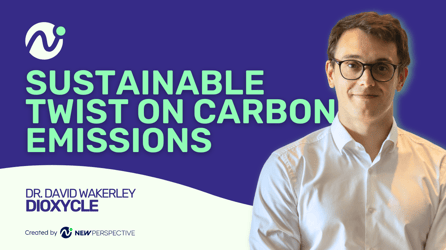Episode Info
Meet Annette Eros, Chief Executive Officer of the Arctic Ice Project, a nonprofit committed to preserving Arctic ice to mitigate climate change. Learn how their technology, involving the strategic placement of small hollow glass beads over the ice, amplifies its reflectivity, counteracting the effects of warming oceans.
Web: arcticiceproject.org
LI: @arcticiceproject
IG: @arcticiceproject
TW: @ArcticIceProj
FB: @ArcticIceProject
YT: @arcticiceproject
Watch the episode below
Read the interview with Annete Eros, CEO of Artic Ice Project
Dunja Jovanovic: Welcome to the Green New Perspective Podcast, Annette. We appreciate you being here. Could you please share with our audience more about your work and the objectives of the Arctic Ice Project in combating climate change?
Annette Eros: Thank you, Dunja. It's a pleasure to be here. Our organization is a nonprofit dedicated to stabilizing the global climate by safely preserving and restoring Arctic sea ice. The Arctic holds significant importance in the context of climate change and the trajectory we are heading towards.
I'd like to highlight the extent of its influence on future outcomes. Currently, the Arctic is warming at a rate four times faster than the rest of the Earth, which is even faster than previously thought when we believed it was warming at twice the speed. This accelerated rate of warming is crucial to comprehend.
Greenhouse gasses are widely recognized as the primary contributors to climate change. However, a recent article highlighted that ice-free summers in the Arctic are inevitable, possibly occurring as early as the 2030s. This implies that during summers when the sun shines 24 hours a day, there would be no sea ice present. If we reach this point, the Arctic alone would contribute 25% to global warming, while greenhouse gasses would account for the remaining 75%.
DJ: Essentially, the Arctic becomes the second major contributor to the global warming scenario we find ourselves in.
AE: Many people are unaware of the Arctic's critical role in this equation. In the past, we viewed Arctic melting as a symptom of climate change. However, with the accelerated melting rate, we now understand it actively contributes to global warming. The 75%-25% split is not merely a case of ice melting due to global warming.
It represents a cycle where the Arctic's melting, occurring at an alarming pace, becomes a significant factor in amplifying global warming. Therefore, people must recognize the Arctic's significance in this complex issue.
Years ago, before the 1970s, the Arctic acted as an effective natural heat shield for the Earth by reflecting solar energy from the sun back into the atmosphere. This balanced system persisted until human emissions began disrupting it.
Now, instead of being reflected, too much of the sun's energy is absorbed into the ocean, leading to instability. The Arctic's role as a heat shield is essential for maintaining this balance, and ice is a critical component of that process.
This is why we focus our efforts on the Arctic. It plays a vital role that cannot be ignored, and we are unaware of any other organizations specifically addressing its significance. While various groups are working on ocean-related issues, the Arctic, where ice is disappearing rapidly, is often neglected.
We are at a critical juncture, and when we mention the 2030s, it is important to remember that this is merely a decade away, affecting our lifetime rather than future generations.
DJ: Can you provide some insights into the technologies being developed by the Arctic Ice Project to mitigate climate change?
AE: Sea ice can reflect 30% to 80% of the sunlight that reaches it, known as the albedo effect. This function is crucial in redirecting solar energy back into the atmosphere. On the other hand, ocean water absorbs 95% of sunlight, contributing to the warming of the Earth.
If we lose the Arctic sea ice, this cycle of absorption and warming continues and accelerates. Our goal is to enhance the albedo effect, allowing the ice to reflect more of the sun's energy.
We specifically focus on young ice, which refers to ice that is approximately less than one year old. Young ice absorbs more sunlight compared to older ice, which is several meters thick and has survived a summer melt season and many have been present in the Arctic for many years.
Multi-year ice possesses greater reflective properties than young ice. During the summer, when the sun shines 24 hours a day, young ice is particularly vulnerable as it hasn't had sufficient time to develop reflective properties. Our solution aims to address this issue.
We utilize small hollow glass beads made of silica, similar to the composition of sand. These beads are smaller than the circumference of a strand of hair, resembling fine dust. They possess exceptional reflective properties, capable of reflecting up to 60% of the sun's energy. The concept involves spreading a thin layer of these glass beads strategically over targeted areas of the Arctic.
This would enhance the reflection of sunlight and protect the ice from melting, especially young ice, allowing it to survive through the summer and develop stronger reflective properties during the colder winter months.
By safeguarding the ice, we can reduce the rate of ice melt and decelerate the effects of climate change. We have substantial evidence supporting the feasibility of this approach. It is considered one of the most promising climate mitigation efforts thus far.
We can effectively slow down the rate of climate change in a safe, controlled, and cost-efficient manner, especially when compared to the costs associated with inaction, which are becoming increasingly evident through the various catastrophes occurring around the world.
DJ: I came across information suggesting that your project and scientific research provide an opportunity to extend the timeline for world economies to decarbonize by up to 15 years. Can you elaborate on this?
AE: Absolutely. We believe that our project offers a significant solution and an important tool in combating climate change. While we don't currently have evidence to suggest that our solution can reverse climate change, we do believe that it can have a substantial impact by reducing the Arctic's contribution to global warming.
We aim to buy an additional 10 to 15, or even 20 years, by preserving the Arctic ice. If we can prevent the inevitable disappearance of ice during the summer, it will give us a crucial resource to work with. Slowing down the rate of ice melt is essential at this point. We need additional tools to address the challenges we face globally.
It is not feasible to cover the entire Arctic, given its vast expanse. Moreover, safety is paramount. We must ensure that introducing this product into the Arctic environment has no unintended negative consequences. We are conducting ecotoxicology studies, examining the impact on the Arctic food chain, starting from microorganisms and progressing now to fish.
So far, the results indicate that it is quite safe, which is encouraging. However, should any concerns arise, we will reassess and explore alternative approaches. Our goal is to transition from lab experiments to field testing. Once we have sufficient data supporting the safety of our approach, we can progress to obtaining permits, securing additional funding, and collaborating with partners for real-world field testing.
DJ: When I shared with my friends that I would be interviewing you and explaining your project, they were curious about how you plan to deploy those tiny silica beads. Can you provide some insight into your deployment strategy?
AE: Ensuring that our approach is eco-friendly is a top priority for us. We want to avoid using fuel-burning airplanes or other alternatives that will have negative effects on the Arctic. So, we are exploring various options to achieve a safe and environmentally conscious deployment.
One idea we are considering is leveraging electric ships, which are already being developed in Norway. These ships could transport the product as close as possible to the deployment areas. Subsequently, we may utilize drones or similar technologies to distribute and deploy the silica beads from the ships. We are committed to identifying deployment measures that prioritize safety and eco-friendliness.
It's crucial to avoid solving one problem while creating others. We are aware of the potential negative feedback loop that could arise from unsustainable deployment methods. As part of our ongoing five-year technology plan, we will continue working on finding the most suitable and environmentally friendly deployment strategies.
The field of electric-based technologies is rapidly advancing, and we are exploring options that align with our goals. Each passing year brings advances in available deployment options, but we must balance available technological progress with the urgent need for action. Ultimately, our goal is to be ready to deploy the solution effectively and timely. We recognize the urgency and importance of getting our approach out into action.
DJ: Collaboration is crucial in the clean tech, naturetech, and biotech space, as my previous podcast guests have emphasized. Have you had the opportunity to collaborate with other organizations or partners to achieve your goals?
AE: Collaboration is crucial in the climate community, and we actively engage in partnerships to accelerate our progress. We have strategically shifted from conducting all research internally to collaborating with organizations and experts.
For example, we collaborate with Arctic experts in Norway, SINTEF Ocean, for safety research, benefiting from their specialized and expert knowledge. We have also worked with organizations like NASA Ames, who generously provided us with supercomputer time for data analysis and modeling. Our Scientific Advisory Board, comprising global experts, guides our scientific advancements and areas of focus.
We receive funding from donor organizations globally, including India, and from local community organizations and foundations in Silicon Valley. Collaboration goes beyond financial support, as we seek to share information and involve diverse stakeholders, including indigenous communities, in decision-making processes.
DJ: It must have been quite challenging to present your innovative technology, especially to those who are not familiar with the cleantech space. Could you discuss the obstacles you've faced and the messages you convey to showcase your projects and research?
AE: Absolutely. While the concept itself may seem simple, the real challenge lies in the implementation and understanding of the effects. Some of our success stories stem from introducing novel ideas that spark interest and curiosity. It has taken us years to reach where we are today and establish proof of concept.
Initially, it was a struggle to gain support and recognition, particularly because the Arctic focus is unique, and many are directing their attention and resources toward other areas like carbon sequestration. Raising awareness about the importance of the Arctic, its significant role in our survival, and helping it become an active priority has been surprisingly difficult.
Our modeling work demonstrates that preserving and enhancing ice cover has a cooling effect on the Arctic and the entire globe, influencing weather patterns and sea currents. Educating people about these critical aspects is essential, and it's already a part of our ongoing efforts.
We create videos, share articles, and provide messaging to help individuals understand why our work is vital. We're all affected by climate change, and it's challenging to confront the potential consequences and the need for immediate action. However, contributing to an organization financially is a significant way to engage.
While personal actions like driving electric cars, recycling, and composting are commendable, supporting our research provides a tangible way to make a meaningful difference, both for the present and future generations.
DJ: Since we are a marketing agency, I'm curious to know how marketing has contributed to the dissemination of your messages. In what ways has marketing been beneficial to your organization and how has it helped you achieve your goals?
AE: Marketing is integral to our mission. It educates people about the Arctic's significance in climate change and helps secure funding. We allocate resources to marketing to ensure a broader understanding and convey a message of hope.
Collaborating with platforms like your Green New Perspective, we aim to demonstrate that dedicated individuals and organizations are working towards positive change. Our recent successful fundraiser brought together diverse supporters, reinforcing the power of community. With continuous improvements and an emphasis on accessibility, we strive to create interactive content on social platforms.
DJ: My next question was about your mission communication and how it has evolved. But I understand that you're moving towards digital platforms and simplifying your language. Is that correct?
AE: Absolutely. Our goal is to ensure the widespread understanding and transferability of our technology. We intend to collaborate with organizations like the military and/or international consortia to activate deployment.
Our communication strategy involves engaging various stakeholders, including politicians and international groups, through policy discussions. We've found that framing our message in terms of security resonates well in politics and fosters collaboration. As we progress, our target audience and collaborations will evolve.
We aim to change the perception of our work from negative geoengineering to a positive climate restoration solution. We prioritize thoughtfulness, transparency, and creating a safe future. Sharing data and exploring broader applications are essential for maximizing the benefits of our work.
DJ: What are the upcoming plans and projects that the Arctic Ice Project has in store for the future to advance its mission and increase its impact?
AE: Our focus will remain on the Arctic, where we hope to see the benefits of our efforts materialize. We will continue our research and development efforts, ensuring safety remains a priority.
It is disheartening that news about the inevitable loss of Arctic ice doesn't receive the attention it deserves. However, we are determined to stay committed to education, research, solutions and generating hope. We believe our work can have a tremendous global impact, addressing the unequal effects of climate change and promoting equity.




